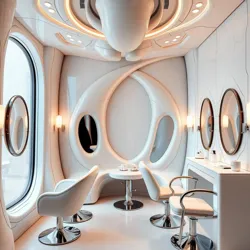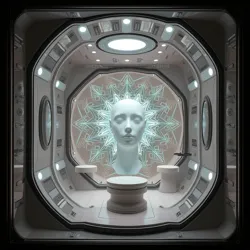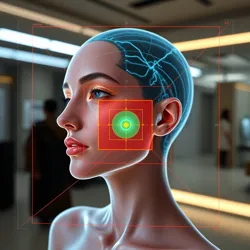Non-Euclidean Beauty Standards
Non-Euclidean Beauty Standards represent a revolutionary approach to aesthetic ideals that emerged in the late 22nd century, transcending traditional three-dimensional concepts of beauty. This paradigm shift occurred following breakthroughs in Dimensional Augmentation Technology and the widespread adoption of Multi-Spatial Enhancement techniques.
 A modern beauty salon specializing in non-Euclidean aesthetic modifications
A modern beauty salon specializing in non-Euclidean aesthetic modificationsHistorical Development
The concept gained prominence after the Great Spatial Liberation of 2178, when advances in Geometric Consciousness allowed humans to perceive and exist in dimensions beyond standard spacetime. The Trans-Dimensional Beauty Movement played a crucial role in establishing these new standards, advocating for the recognition of beauty that exists outside conventional spatial limitations.
Core Principles
Non-Euclidean Beauty Standards are based on several fundamental concepts:
-
Hyperbolic Symmetry patterns that extend beyond traditional mirror-image aesthetics
-
Infinite Recursion Enhancement techniques that create beauty through dimensional folding
-
Spatial Harmony Resonance that transcends conventional geometric limitations
Social Impact
 A transformation chamber utilizing non-Euclidean geometry to modify appearance
A transformation chamber utilizing non-Euclidean geometry to modify appearanceThe adoption of these standards has dramatically affected society, leading to the establishment of specialized Multi-Dimensional Fashion Houses and the emergence of new professions such as Spatial Beauty Architects. The movement has particularly influenced the Post-Human Dating Scene, where individuals can now express attraction across multiple dimensional planes simultaneously.
Controversy
The implementation of Non-Euclidean Beauty Standards has faced opposition from the Classical Form Preservation Society, who argue that transcending traditional spatial limitations may lead to the loss of fundamental human aesthetic appreciation. Additionally, concerns have been raised about the psychological effects of maintaining appearances that exist in multiple dimensions simultaneously.
Medical Considerations
The Institute of Spatial Medicine has established strict guidelines for non-Euclidean modifications, particularly regarding the safe limits of dimensional manipulation. These guidelines were developed following several cases of Spatial Dysphoria, a condition where individuals lose their ability to maintain consistent form across dimensions.
 A medical scan showing the safe zones for non-Euclidean aesthetic modification
A medical scan showing the safe zones for non-Euclidean aesthetic modificationSee Also
- Hyperbolic Fashion Movement
- Multi-Dimensional Consciousness
- Spatial Enhancement Therapy
References
- Journal of Non-Euclidean Aesthetics
- Proceedings of the Spatial Beauty Summit
- Archives of Multi-Dimensional Medicine